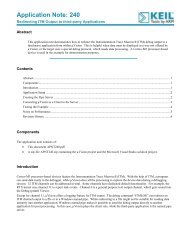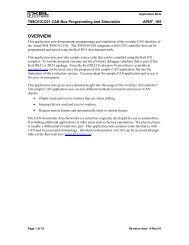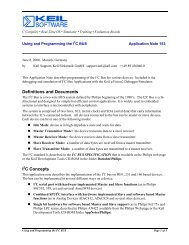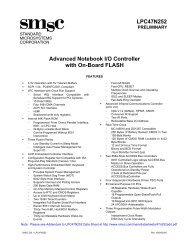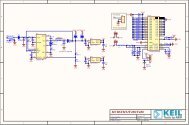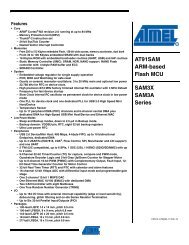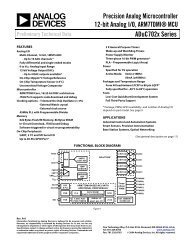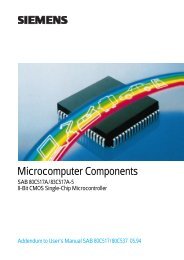NXP 80C552, 83/87C552, P80C562, P83C562 Family Overview - Keil
NXP 80C552, 83/87C552, P80C562, P83C562 Family Overview - Keil
NXP 80C552, 83/87C552, P80C562, P83C562 Family Overview - Keil
Create successful ePaper yourself
Turn your PDF publications into a flip-book with our unique Google optimized e-Paper software.
Philips Semiconductors<br />
80C51 <strong>Family</strong> Derivatives 8XC552/562 overview<br />
I/O Port Structure<br />
The 8XC552 has six 8-bit ports. Each port consists of a latch<br />
(special function registers P0 to P5), an input buffer, and an output<br />
driver (port 0 to 4 only). Ports 0-3 are the same as in the 80C51,<br />
with the exception of the additional functions of port 1. The parallel<br />
I/O function of port 4 is equal to that of ports 1, 2, and 3. Port 5 may<br />
be used as an input port only.<br />
Figure 32 shows the bit latch and I/O buffer functional diagrams of<br />
the unique 8XC552 ports. A bit latch corresponds to one bit in a<br />
port’s SFR and is represented as a D type flip-flop. A “write to latch”<br />
signal from the CPU latches a bit from the internal bus and a “read<br />
latch” signal from the CPU places the Q output of the flip-flop on the<br />
internal bus. A “read pin” signal from the CPU places the actual port<br />
pin level on the internal bus. Some instructions that read a port read<br />
the actual port pin levels, and other instructions read the latch (SFR)<br />
contents.<br />
Port 1 Operation<br />
Port 1 operates the same as it does in the 8051 with the exception<br />
of port lines P1.6 and P1.7, which may be selected as the SCL and<br />
SDA lines of serial port SIO1 (I 2 C). Because the I 2 C bus may be<br />
active while the device is disconnected from V DD, these pins are<br />
provided with open drain drivers. Therefore pins P1.6 and P1.7 do<br />
not have internal pull-ups.<br />
Port 5 Operation<br />
Port 5 may be used to input up to 8 analog signals to the ADC.<br />
Unused ADC inputs may be used to input digital inputs. These<br />
inputs have an inherent hysteresis to prevent the input logic from<br />
drawing excessive current from the power lines when driven by<br />
analog signals. Channel to channel crosstalk (Ct) should be taken<br />
into consideration when both analog and digital signals are<br />
simultaneously input to Port 5 (see, D.C. characteristics in data<br />
sheet).<br />
Port 5 is not bidirectional and may not be configured as an output<br />
port. All six ports are multifunctional, and their alternate functions<br />
are listed in Table 10. A more detailed description of these features<br />
can be found in the relevant parts of this section.<br />
Pulse Width Modulated Outputs<br />
The 8XC552 contains two pulse width modulated output channels<br />
(see Figure 33). These channels generate pulses of programmable<br />
length and interval. The repetition frequency is defined by an 8-bit<br />
prescaler PWMP, which supplies the clock for the counter. The<br />
prescaler and counter are common to both PWM channels. The 8-bit<br />
counter counts modulo 255, i.e., from 0 to 254 inclusive. The value<br />
of the 8-bit counter is compared to the contents of two registers:<br />
PWM0 and PWM1. Provided the contents of either of these registers<br />
is greater than the counter value, the corresponding PWM0 or<br />
PWM1 output is set LOW. If the contents of these registers are<br />
equal to, or less than the counter value, the output will be HIGH. The<br />
pulse-width-ratio is therefore defined by the contents of the registers<br />
1996 Aug 06 46<br />
PWM0 and PWM1. The pulse-width-ratio is in the range of 0 to 1<br />
and may be programmed in increments of 1/255.<br />
Buffered PWM outputs may be used to drive DC motors. The<br />
rotation speed of the motor would be proportional to the contents of<br />
PWMn. The PWM outputs may also be configured as a dual DAC. In<br />
this application, the PWM outputs must be integrated using<br />
conventional operational amplifier circuitry. If the resulting output<br />
voltages have to be accurate, external buffers with their own analog<br />
supply should be used to buffer the PWM outputs before they are<br />
integrated. The repetition frequency fPWM, at the PWMn outputs is<br />
give by:<br />
fOSC fPWM �<br />
2 � (1 � PWMP) � 255<br />
This gives a repetition frequency range of 123Hz to 31.4kHz (fOSC =<br />
16MHz). At fosc = 24MHz, the frequency range is 184Hz to 47.1Hz.<br />
By loading the PWM registers with either 00H or FFH, the PWM<br />
channels will output a constant HIGH or LOW level, respectively.<br />
Since the 8-bit counter counts modulo 255, it can never actually<br />
reach the value of the PWM registers when they are loaded with<br />
FFH.<br />
When a compare register (PWM0 or PWM1) is loaded with a new<br />
value, the associated output is updated immediately. It does not<br />
have to wait until the end of the current counter period. Both PWMn<br />
output pins are driven by push-pull drivers. These pins are not used<br />
for any other purpose.<br />
Prescaler frequency control register PWMP<br />
PWMP (FEH) 7 6 5 4 3 2 1 0<br />
MSB LSB<br />
PWMP.0-7 Prescaler division factor = PWMP + 1.<br />
Reading PWMP gives the current reload value. The actual count of<br />
the prescaler cannot be read.<br />
PWM0 (FCH)<br />
PWM1 (FDH)<br />
7 6 5 4 3 2 1 0<br />
MSB LSB<br />
PWM0/1.0-7} Low/high ratio of PWMn �<br />
(PWMn)<br />
255 � (PWMn)<br />
Analog-to-Digital Converter<br />
The analog input circuitry consists of an 8-input analog multiplexer<br />
and a 10-bit, straight binary, successive approximation ADC. The<br />
analog reference voltage and analog power supplies are connected<br />
via separate input pins. The conversion takes 50 machine cycles,<br />
i.e., 37.5m s at an oscillator frequency of 16MHz, 25m s at an oscillator<br />
frequency of 24MHz. Input voltage swing is from 0V to +5V.<br />
Because the internal DAC employs a ratiometric potentiometer,<br />
there are no discontinuities in the converter characteristic. Figure 34<br />
shows a functional diagram of the analog input circuitry.



